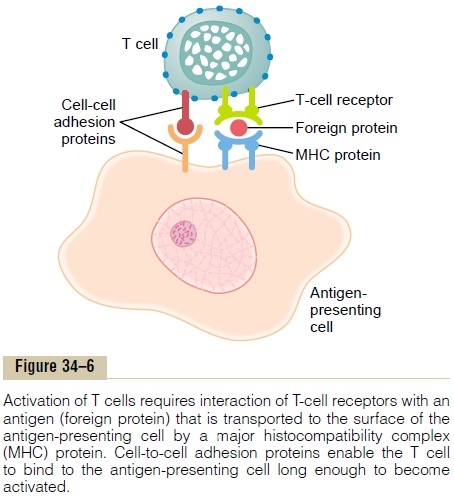Chapter: Medical Physiology: Resistance of the Body to Infection: II. Immunity and Allergy
Special Attributes of the T-Lymphocyte System - Activated T Cells and Cell-Mediated Immunity
Special Attributes of the T-Lymphocyte System - Activated T Cells and Cell-Mediated Immunity
Release of Activated T Cells from Lymphoid Tissue and Forma-tion of Memory Cells. On exposure to the proper antigen,as presented by adjacent macrophages, the T lympho-cytes of a specific lymphocyte clone proliferate and release large numbers of activated, specifically reacting T cells in ways that parallel antibody release by activated B cells. The principal difference is that instead of releasing antibodies, whole activated T cells are formed and released into the lymph. These then pass into the circulation and are distributed through-out the body, passing through the capillary walls into the tissue spaces, back into the lymph and blood once again, and circulating again and again throughout the body, sometimes lasting for months or even years.
Also, T-lymphocyte memory cells are formed in the same way that B memory cells are formed in the anti-body system. That is, when a clone of T lymphocytes is activated by an antigen, many of the newly formed lymphocytes are preserved in the lymphoid tissue to become additional T lymphocytes of that specific clone; in fact, these memory cells even spread through-out the lymphoid tissue of the entire body. Therefore, on subsequent exposure to the same antigen anywhere in the body, release of activated T cells occurs far more rapidly and much more powerfully than had occurred during first exposure.
Antigen-Presenting Cells, MHC Proteins, and Antigen Recep-tors on the T Lymphocytes. T-cell responses are extremelyantigen specific, like the antibody responses of B cells, and are at least as important as antibodies in de-fending against infection. In fact, acquired immune responses usually require assistance from T cells to begin the process, and T cells play a major role in actu-ally helping to eliminate invading pathogens.

Although B lymphocytes recognize intact antigens, T lymphocytes respond to antigens only when they are bound to specific molecules called MHC proteins on the surface of antigen-presenting cells in the lymphoid tissues (Figure 34–6). The three major types of antigen-presenting cells are macrophages, B lympho-cytes, and dendritic cells. The dendritic cells, the mostpotent of the antigen-presenting cells, are located throughout the body, and their only known function is to present antigens to T cells. Interaction of cell adhe-sion proteins is critical in permitting the T cells to bindto antigen-presenting cells long enough to become activated.
The MHC proteins are encoded by a large group of genes called the major histocompatibility complex(MHC). The MHC proteins bind peptide fragmentsof antigen proteins that are degraded inside antigen-presenting cells and then transport them to the cell surface. There are two types of MHC proteins: (1) MHC I proteins, which present antigens to cytotoxic T cells, and (2) MHC II proteins, which present antigensto T helper cells. The specific functions of cytotoxic and helper T cells are discussed later.
The antigens on the surface of antigen-presenting cells bind with receptor molecules on the surfaces of T cells in the same way that they bind with plasma protein antibodies. These receptor molecules are com-posed of a variable unit similar to the variable portion of the humoral antibody, but its stem section is firmly bound to the cell membrane of the T lymphocyte. There are as many as 100,000 receptor sites on a single T cell.
Related Topics